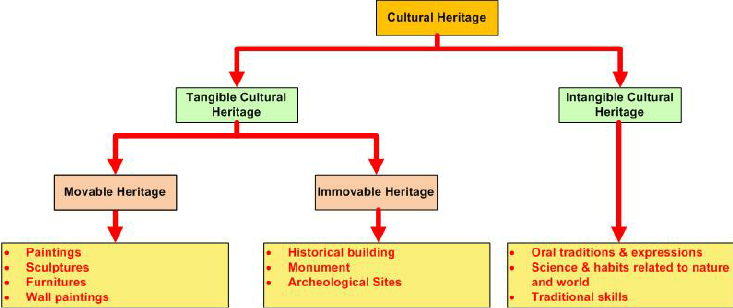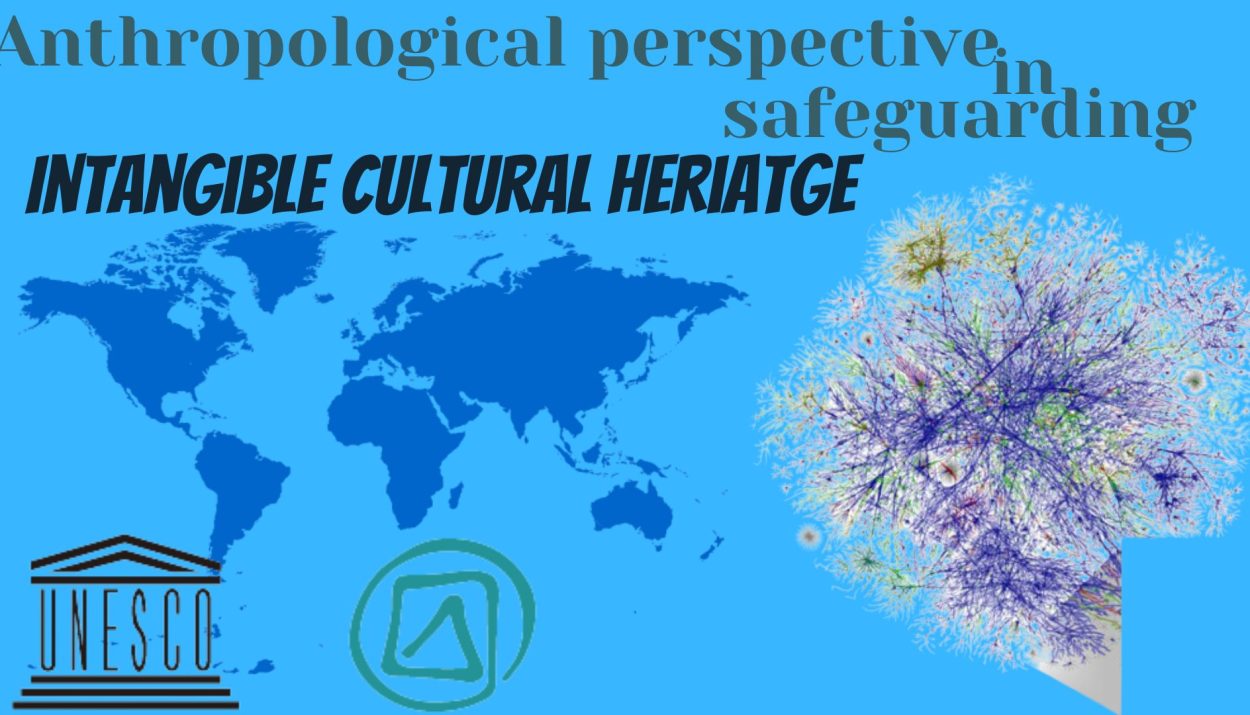Intangible cultural practices, such as rituals, traditions, oral histories, music and language are the essence of human societies, shaping identities and fostering a sense of belonging. As globalization and modernization threaten the continuity of these practices, safeguarding them becomes paramount to preserving cultural diversity. Anthropologists play a vital role in understanding, documenting and collaborating with communities to ensure the preservation of intangible cultural practices. Applying an anthropological perspective in safeguarding Intangible Cultural Heritage helps us appreciate the cultural significance of these practices and their interconnection with the social fabric of communities.
Read- Anthropology of Heritage
What is Cultural Heritage?
Cultural heritage refers to the legacy of tangible and intangible attributes, traditions and customs that are inherited from past generations and preserved for future generations. It encompasses the unique and diverse aspects of society, including its art, architecture, language, music, dance, literature, cuisine, rituals, beliefs and other forms of expression. Cultural heritage is an essential part of a community’s identity and plays a crucial role in shaping its collective memory, values and sense of belonging.

Cultural heritage can be classified into two main categories:
Tangible Cultural Heritage: This includes physical artefacts and structures that hold historical, artistic or cultural significance. Examples of tangible cultural heritage are ancient buildings, monuments, sculptures, paintings, artefacts, archaeological sites and traditional craftsmanship.
Intangible Cultural Heritage: This aspect includes non-physical elements of a culture that are transmitted orally, through performances, or social practices. Intangible cultural heritage includes folk songs, dances, rituals, festivals, traditional knowledge, language, traditional craftsmanship techniques and other forms of artistic expression.
Convention for the Safeguarding of Intangible Cultural Heritage
The Convention for the Safeguarding of Intangible Cultural Heritage is an international treaty adopted by the United Nations Educational, Scientific and Cultural Organization (UNESCO) in 2003. The primary purpose of this convention is to safeguard and protect the world’s intangible cultural heritage, which includes practices, representations, expressions, knowledge and skills – as well as the instruments, objects, artefacts and cultural spaces associated therewith – that communities, groups and, in some cases, individuals recognize as part of their cultural heritage passed down from generation to generation.
Intangible cultural heritage is inherently tied to the present, encompassing living expressions and practices that communities currently recognize as part of their cultural heritage. It should be noted that historical expressions that are no longer actively practised form an essential part of cultural history but do not fall under the purview of intangible cultural heritage as defined in the Convention for the Safeguarding of Intangible Cultural Heritage. Hence, intangible cultural heritage is often referred to as “living heritage” due to its immediate relevance and ongoing significance within contemporary societies.
UNESCO established its List of Intangible Cultural Heritage to raise awareness, promote appreciation and encourage the safeguarding of these unique cultural expressions. It aims to draw attention to the importance of safeguarding intangible heritage. To maintain the lists’ relevance and accuracy, UNESCO periodically reviews the inscribed elements to assess their status and the effectiveness of safeguarding measures. New nominations can also be submitted by member states to add deserving elements to the lists.
Explore the heritage of Yoga, inscribed on the list of intangible cultural heritage.
Importance of Intangible Cultural Heritage
Preserving Identity and Diversity: Intangible cultural heritage is closely linked to the identity and sense of belonging of communities. It reflects their unique ways of life, values and worldview. By safeguarding intangible cultural heritage, diverse communities can preserve their identities and ensure that their distinct traditions and knowledge continue to be celebrated and passed down to future generations.
Building Social Cohesion: Intangible cultural heritage often involves collective activities and rituals that bring communities together. Participating in shared cultural practices fosters a sense of unity and strengthens social cohesion within a group, promoting mutual understanding and tolerance among its members.
Transmitting Knowledge and Skills: Intangible cultural heritage encompasses a wide range of knowledge, skills and craftsmanship that have been developed and refined over generations. From traditional medicine to artisanal craftsmanship, these skills are often passed down through direct observation and hands-on learning, contributing to the continuity of valuable knowledge and expertise.
Fostering Creativity and Innovation: Intangible cultural heritage is not stagnant; it evolves and adapts over time. It serves as a source of inspiration for contemporary artists, performers and creators, encouraging them to reinterpret and innovate while staying connected to their cultural roots.
Promoting Sustainable Development: Many aspects of intangible cultural heritage are closely related to sustainable practices and resource management. Traditional ecological knowledge, sustainable agriculture methods and craftsmanship using local materials are examples of intangible heritage that can contribute to sustainable development and environmental preservation.
Enhancing Cultural Exchange and Dialogue: Intangible cultural heritage provides a platform for cultural exchange and dialogue between different communities. By sharing their traditions and practices, communities can promote mutual respect and appreciation for each other’s cultures, fostering a more inclusive and interconnected global society.
Economic Benefits: Intangible cultural heritage often attracts tourists and visitors, leading to cultural tourism and economic opportunities for communities involved in preserving and showcasing their traditions. This can result in income generation and improved livelihoods for local practitioners and artisans.
Strategies and actions that can help safeguard and promote Intangible Cultural Heritage
Documentation and Research: Anthropologists conduct thorough research and documentation of intangible cultural heritage practices, including rituals, traditions, language, music, dance, and crafts. This involves recording interviews with elders and practitioners, archiving audio-visual materials and compiling written documentation to create a comprehensive record of these living expressions.
Community Involvement and Ownership: Communities should be actively involved in the preservation process, as they are the primary carriers and practitioners of their intangible cultural heritage. Encourage their participation in decision-making, planning and implementation of preservation initiatives, respecting their intellectual property rights and ensuring that they retain ownership of their heritage.
Education and Awareness: Raise awareness about the importance of intangible cultural heritage among community members, the general public and policymakers. Educational programs, workshops, seminars and cultural festivals can play a crucial role in fostering appreciation and understanding of intangible heritage.
Capacity Building: Empower community members and practitioners to safeguard their heritage by providing training in traditional skills, rituals and performance arts. This may involve workshops on traditional craftsmanship, music, dance, storytelling and other forms of cultural expression.
Intergenerational Transmission: Facilitate intergenerational knowledge transfer by encouraging elders to pass on their knowledge and skills to the younger generation. Apprenticeships, mentorship programs and family-based learning can be effective ways to ensure continuity.
Cultural Exchange and Collaboration: Promote cultural exchange programs between communities to share knowledge, practices and experiences. Collaboration with cultural experts, scholars and researchers can also enrich preservation efforts.
Support for Practitioners: Provide financial and institutional support to practitioners and artists involved in safeguarding intangible cultural heritage. Grants, scholarships and subsidies can incentivize their dedication and commitment.
Digital Archiving: Create digital repositories and archives to store and disseminate documentation of intangible cultural heritage. This ensures easy access and preservation of information for future generations.
Cultural Tourism: Develop sustainable cultural tourism initiatives that respect the integrity of the intangible cultural heritage while providing economic benefits to the communities involved.
Policy and Legal Frameworks: Establish legal frameworks and policies that recognize and protect intangible cultural heritage at the national and international levels. Ratification of relevant UNESCO conventions and the integration of safeguarding measures into national laws are essential steps in this regard.
By implementing these strategies, communities can actively contribute to preserving their intangible cultural heritage, ensuring that these valuable traditions continue to thrive and enrich human culture for generations to come.
Conclusion
Intangible cultural heritage stands as a testament to the enduring wisdom, creativity and diversity of human societies. Through its living expressions, traditions and practices, it binds communities together, transcending time and borders. As an invaluable part of our shared heritage, its safeguarding is paramount to fostering cultural identity, promoting intercultural dialogue and nurturing mutual respect. Embracing the richness of intangible cultural heritage paves the way for a more inclusive and harmonious world, where the treasures of the past and present unite to shape a vibrant and culturally enriched future for generations to come.
References
2003 Convention for the Safeguarding of the Intangible Cultural Heritage

